Along the coast at Baclayon parish, founded by the Jesuits in 1596, stands a fortress church built in 1727, with a bell tower which doubled as a watch tower to guard against Muslim pirates from Mindanao in the south. The weathered walls, nearly 2m thick, house a number of religious relics, protected at the entrance by an armed guard nursing a pump-action shotgun.
Polished silver and chipped plaster images of a bleeding, suffering Christ stand alongside an ornate, life-size statue of the Virgin Mary, used in the Baclayon Easter festival, a hymn book written in Latin and bound in buffalo hide lies open on a pedestal. The white walls of woven bamboo, plastered with a mix of coral mud and egg white leads to a heavy door which opens to the Tribuna, a shadowed viewing balcony hidden behind heavy diagonal lattice which overlooks the altar, reserved for priests’ guests attending mass. Paintings of the Stations of The Cross line the walls and the mahogany floors upstairs, held in place with wooden pegs, polished by the millions of footsteps of priests who paced and prayed for deliverance of the parish from Muslim marauders.
At Loboc, the sweaty humidity of inland travel can be cooled with a cruise on the river, past the three-storey Jesuit convento, a priests’ residence built in 1600. The Loboc River, 21km long and hemmed by jungle, winds past small thatched huts on stilts, with pump boats carrying tourists regularly “attacked” by laughing children who swing into the water from the banks on ropes tied to overhanging tree branches.
Loboc also offers another interesting experience – a face-to-face meeting with a creature which could easily have been created by ET director Steven Spielberg. Tarsiers are believed to be the world’s smallest living primate, whose origins date back 36 million years. With a furry body about 10cm to 12cm long, fixed nocturnal eyes as large as 20c pieces and a head that can rotate almost 360 degrees, these long-fingered mini-monkeys are incredibly cute.
Decades ago, tarsiers were the focus of a lucrative taxidermist trade, with tourists of the time keen to take home a stuffed creature which was likened to “God’s creation of a perfect children’s toy”. Where once they were abundant, tarsiers today live in pockets of forest on Bohol and are an endangered species. An open reserve has been established at Corella, west of Loboc, where these unique creatures are protected, but visitors to Loboc can touch and photograph tame tarsiers.
Travelling inland by mini bus, the traffic thins, the roads become rougher and life takes on a gentler pace, with white herons strutting in the rice paddies on the flatland as the road climbs to Bilar through lush jungle and a man-made mahogany forest planted in the 1960s as part of a reforestation program, then winds towards Carmen and the Chocolate Hills.
The 1,268 cone-shaped hills ranging from 40m to 120m high, are a geological oddity, created millions of years ago through the movement of water which formed sand mounds on an ancient seabed. In summer, the grass-covered limestone hills turn brown, a vision which an unsubtle American official likened to hundreds of Hershey chocolate kisses.
What better reason to name an ancient geological formation the Chocolate Hills? 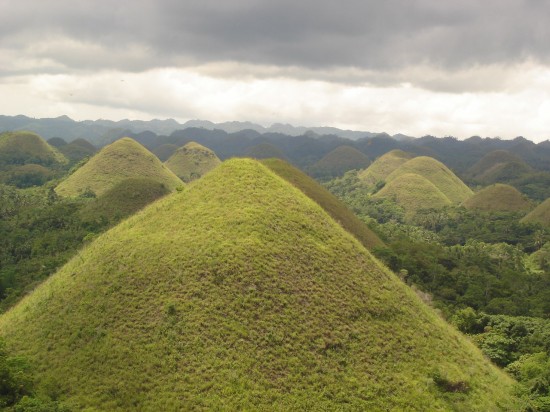
Things To Try
Balut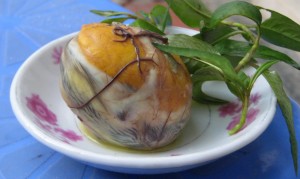 A two-week old duck embryo, boiled in the shell and eaten as a quick snackfood with salt. Eaten by children and adults alike, the pin feathers, formed head and tiny beaks don’t seem to be a put-off. Balut vendors come out at night to sell their wares in cities like Manila, Cebu and Tagbilaran, for a few pesos. It is eaten as an energy booster by taxi and tricycle drivers who work late at night, or as an appetizer with a casual drink.
A two-week old duck embryo, boiled in the shell and eaten as a quick snackfood with salt. Eaten by children and adults alike, the pin feathers, formed head and tiny beaks don’t seem to be a put-off. Balut vendors come out at night to sell their wares in cities like Manila, Cebu and Tagbilaran, for a few pesos. It is eaten as an energy booster by taxi and tricycle drivers who work late at night, or as an appetizer with a casual drink.
Tuba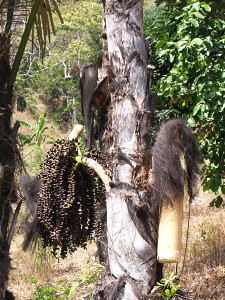 Palm wine, or tuba, is made by gathering sap from the coconut palm. The coconut fruit stem is cut and a bamboo tube inserted to tap the sap. It drips out and in times of heavy rainfall, can produce up to four litres of tuba a day. A gallon (about four litres) of tuba bought from a streetside stall costs about 40 pesos ($1.60). It is drunk as wine for one to three days. At five to ten days old it can be mixed with cola. After three weeks it is vinegar and used for cooking. It is an acquired taste.
Palm wine, or tuba, is made by gathering sap from the coconut palm. The coconut fruit stem is cut and a bamboo tube inserted to tap the sap. It drips out and in times of heavy rainfall, can produce up to four litres of tuba a day. A gallon (about four litres) of tuba bought from a streetside stall costs about 40 pesos ($1.60). It is drunk as wine for one to three days. At five to ten days old it can be mixed with cola. After three weeks it is vinegar and used for cooking. It is an acquired taste.
Check out the other articles in this series:
The Philippines, Part 1 – A Tropical Mosaic
The Philippines, Part 2 – Bohol and Beyond
Photo Credits
Baclayon Parish – Wikipedia Creative Commons
River Cruise – Wikipedia Creative Commons
Tarsier and woman – Asia Hotels
Balut – Wikimedia Creative Commons
Gathering Sap For Palm Wine – Wikipedia Creative Commons


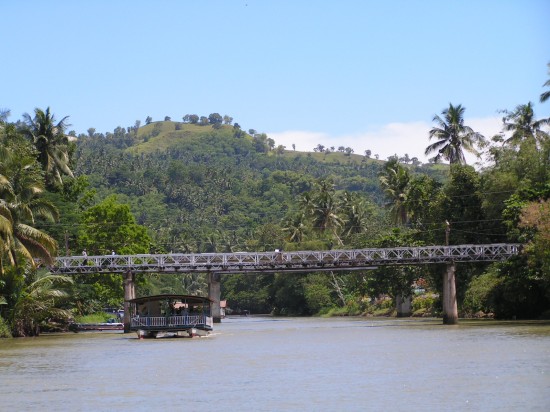
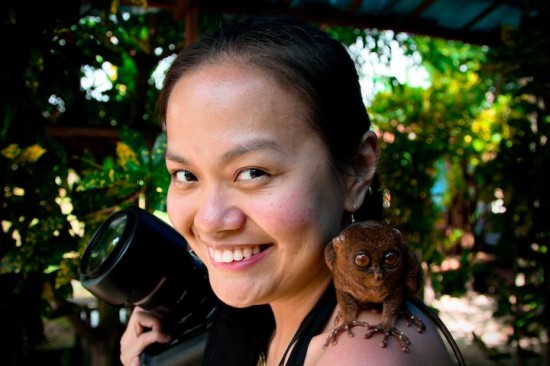

[…] The Philippines, Part 3 – In The Footsteps Of Jesuits […]